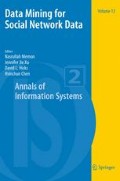Abstract
Decision-making in many application domains needs to take into consideration of some sorts of networks. Examples include e-commerce and marketing [6, 10], strategic planning [21], knowledge management [12], and Web mining [5, 13]. Since the late 1990s a large number of articles have been published in Nature, Science, and other leading journals in many disciplines, proposing new network models, techniques, and applications (e.g., [3, 22, 25]). This trend has been accompanied by the increasing popularity of social networking sites such as FaceBook and MySpace. As a result, research on social network data mining, or simply network mining, has attracted much attention from both academics and practitioners.
Access this chapter
Tax calculation will be finalised at checkout
Purchases are for personal use only
References
Albert, R. and Barabási, A.-L. Statistical mechanics of complex networks. Reviews of Modern Physics, 74(1):47–97, 2002.
Albert, R., Jeong, H. et al. Diameter of the World-Wide Web. Nature, 401:130–131, 1999.
Barabási, A.-L. and Albert, R. Emergence of scaling in random networks. Science, 286(5439):509–512, 1999.
Bianconi, G. and Barabási, A.-L. Competition and multiscaling in evolving networks. Europhysics Letters, 54:436–442, 2001.
Chau, M. and Xu, J. Mining communities and their relationships in blogs: A study of hate groups International Journal of Human-Computer Studies, 65:57–70, 2007.
Domingos, P. and Richardson, M. Mining the network value of customers. In The 7th ACM SIGKDD International Conference on Knowledge Discovery and Data Mining, San Francisco, CA: ACM Press, 2001.
Faloutsos, M., Faloutsos, P. et al. On power-law relationships of the internet topology. In Annual Conference of the Special Interest Group on Data Communication (SIGCOMM ’99), Cambridge, MA, 1999.
Flake, G.W., Lawrence, S. et al. Efficient identification of web communities. In The 6th International Conference on Knowledge Discovery and Data Mining (ACM SIGKDD 2000), Boston, MA: ACM Press, 2000.
Gibson, D., Kleinberg, J. et al. Inferring web communities from link topology. In The 9th ACM Conference on Hypertext and Hypermedia, Pittsburgh, PA, 1998.
Janssen, M.A. and Jager, W. Simulating market dynamics: Interactions between consumer psychology and social networks. Artificial Life, 9:343–356, 2003.
Jeong, H., Tombor, B. et al. The large-scale organization of metabolic networks. Nature, 407(6804):651–654, 2000.
Kautz, H., Selman, B. et al. Referralweb: Combining social networks and collaborative filtering. Communications of the ACM, 40(3):27–36, 1997.
Kleinberg, J. Authoritative sources in a hyperlinked environment. In The 9th ACM-SIAM Symposium on Discrete Algorithms, San Francisco, CA, 1998.
Kleinberg, J., Sandler, M. et al. Network failure detection and graph connectivity. The 15th Annual ACM-SIAM Symposium on Discrete Algorithms, New Orleans, LA, Society for Industrial and Applied Mathematics, Philadelphia, PA, 2004.
Lawrence, S. and Giles, C.L. Accessibility of information on the web. Nature, 400: 107–109, 1999.
Menczer, F. Evolution of document networks. Proceedings of the National Academy of Science of the United States of America, 101:5261–5265, 2004.
Nahapiet, J. and Ghoshal, S. Social capital, intellectual capital, and the organizational advantage. Academy of Management Review, 23(2):242–266, 1998.
Newman, M.E.J. The structure of scientific collaboration networks. Proceedings of the National Academy of Science of the United States of America, 98:404–409, 2001.
Newman, M.E.J. Coauthorship networks and patterns of scientific collaboration. Proceedings of the National Academy of Science of the United States of America, 101:5200–5205, 2004.
Pennock, D.M., Flake, G.W. et al. Winners don’t take all: Characterizing the competition for links on the web. Proceedings of the National Academy of Science of the United States of America, 99(8):5207–5211, 2002.
Powell, W.W., White, D.R. et al. Network dynamics and field evolution: The growth of interorganizational collaboration in the life sciences. American Journal of Sociology, 110(4):1132–1205, 2005.
Singh, J. Collaborative networks as determinants of knowledge diffusion patterns. Management Science, 51(5):756–770, 2005.
Small, H. Visualizing science by citation mapping. Journal of American Society of Information Science, 50(9):799–813, 1999.
Tu, Y. How robust is the Internet? Nature, 406:353–354, 2000.
Watts, D.J. and Strogatz, S.H. Collective dynamics of “small-world” networks. Nature, 393(6684):440–442, 1998.
Xu, J.J. and Chen, H. CrimeNet Explorer: A framework for criminal network knowledge discovery. ACM Transactions on Information Systems, 23(2):201–226, 2005.
Acknowldgements
The editors would like to gratefully acknowledge the efforts of all those who have helped create this special edition. First, it would never be possible for an edition such as this one to provide such a broad and extensive look at the latest research in the field of social network mining without the efforts of all those expert researchers and practitioners who have authored and contributed papers. Their contributions made this special issue possible. In addition, we would like to thank the reviewers for their time and effort in the preparation of their thoughtful reviews. Their support was crucial for ensuring the quality of this special issue and for attracting wide readership. oreover, we would like to thank the series editors, Ramesh Sharda and Stefan Voß, for their valuable advice, support, and encouragement. We are also grateful for the pleasant cooperation with Neil Levine and Matthew Amboy from Springer and their professional support in publishing this volume.
Author information
Authors and Affiliations
Corresponding author
Editor information
Editors and Affiliations
Rights and permissions
Copyright information
© 2010 Springer US
About this chapter
Cite this chapter
Memon, N., Xu, J.J., Hicks, D.L., Chen, H. (2010). Social Network Data Mining: Research Questions, Techniques, and Applications. In: Memon, N., Xu, J., Hicks, D., Chen, H. (eds) Data Mining for Social Network Data. Annals of Information Systems, vol 12. Springer, Boston, MA. https://doi.org/10.1007/978-1-4419-6287-4_1
Download citation
DOI: https://doi.org/10.1007/978-1-4419-6287-4_1
Published:
Publisher Name: Springer, Boston, MA
Print ISBN: 978-1-4419-6286-7
Online ISBN: 978-1-4419-6287-4
eBook Packages: Business and EconomicsBusiness and Management (R0)

